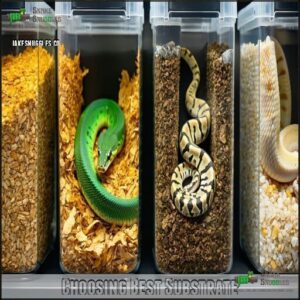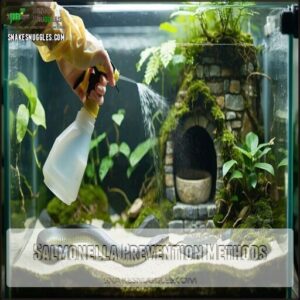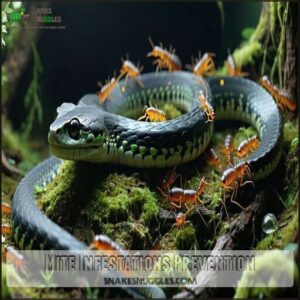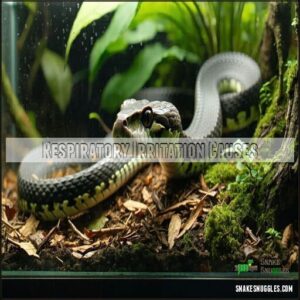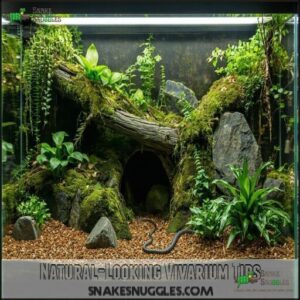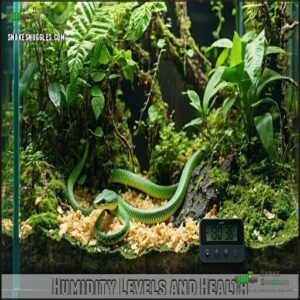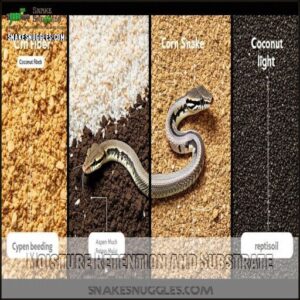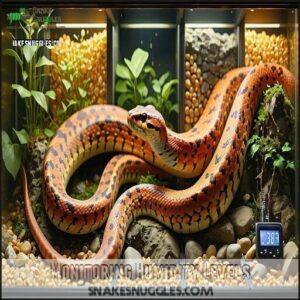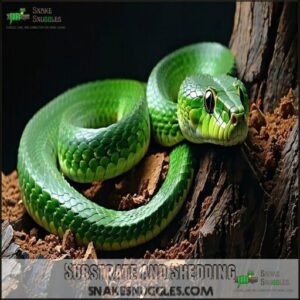This site is supported by our readers. We may earn a commission, at no cost to you, if you purchase through links.
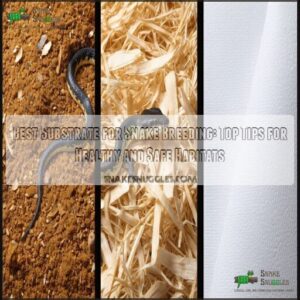
Coconut fiber is fantastic for moisture control, while aspen shavings allow burrowing and stay dry. If simplicity is your style, paper towels or newspaper work wonders—budget-friendly and hygienic!
Avoid pine or cedar; their oils can harm your snakes. Think about your breeding setup’s humidity—if shedding issues pop up, the substrate might need tweaking.
Sometimes, mixing materials helps. Remember, a clean, comfortable habitat is key to happy snakes. Curious about bioactive setups? There’s more to discover!
Table Of Contents
Key Takeaways
- Choose substrates like coconut fiber or aspen shavings for their moisture retention and burrowing support while avoiding pine or cedar due to harmful oils.
- Maintain proper humidity with substrates like cypress mulch, and use tools like hygrometers to ensure levels stay between 50-70% for shedding and egg incubation needs.
- Clean substrates regularly to prevent bacterial growth, respiratory issues, and mite infestations, sticking to low-dust materials that are non-toxic.
- Consider bioactive substrates for a self-sustaining ecosystem that reduces cleaning and promotes your snake’s natural behaviors.
Choosing Best Substrate
Picking the right substrate for snake breeding isn’t just about looks—it’s about creating a safe environment.
You’ll need to take into account factors like humidity, burrowing needs, and ease of cleaning to keep your snakes healthy and thriving.
Factors to Consider
When choosing a breeding substrate, think about your snake’s species needs, size, and natural behaviors.
Consider budget constraints and cleaning ease—newspaper might save cash, while aspen shavings encourage burrowing.
Substrate moisture is key for egg incubation, so pick one that balances humidity control without overcomplicating maintenance.
A well-matched substrate guarantees healthier breeding and happier snakes.
Humidity Control
Maintaining proper humidity levels is key for snake breeding.
Proper humidity levels create a thriving habitat, ensuring smooth shedding, healthy egg incubation, and happy, stress-free snakes.
Use substrates like cypress mulch or coconut fiber for their moisture retention.
Combine misting frequency with deep substrate layers to create humidity gradients.
Proper bedding can serve as humidity control substrate for reptiles.
Add water dishes and make certain enclosure ventilation to avoid excess dampness.
This balance supports egg incubation and shedding while preventing respiratory issues linked to poor humidity control.
Burrowing Requirements
Snakes thrive when their natural behaviors are encouraged, especially tunneling species.
For burrowing, substrate depth matters—aim for at least 3-4 inches, depending on the enclosure size.
Use materials like aspen or coconut fiber to prevent burrow collapse while maintaining humidity levels.
Proper burrowing spaces also aid in egg incubation, making substrate choice essential for successful snake breeding.
Maintenance and Cleaning
Keeping your snake’s enclosure tidy isn’t just about appearances—it’s about their health.
Spot cleaning daily removes waste, while a full replacement every 2-4 weeks guarantees hygiene.
Proper hygiene practices, like monitoring humidity, prevent issues.
Selecting appropriate substrates, such as those with good odor control, is also key.
A clean substrate keeps your snake breeding setup safe and thriving.
Substrate Safety Considerations
When choosing a substrate, you’ve got to prioritize your snake’s safety to avoid common health risks.
From preventing mites to reducing respiratory issues, understanding potential hazards guarantees a secure and healthy habitat.
Salmonella Prevention Methods
When managing substrates for snake breeding, hygiene is your best friend.
Practice safe handling by washing hands after contact with snakes or enclosures.
Disinfecting enclosures regularly stops bacterial growth in its tracks.
Stick to proper waste disposal to limit contamination risks.
Quarantine protocols for new snakes add an extra layer of Salmonella prevention, keeping your habitat—and you—safe.
Mite Infestations Prevention
Though small, mites can wreak havoc on snake health. Prevent infestations with these tips:
- Quarantine Protocols: Isolate new snakes before introducing them.
- Substrate Hygiene: Spot-clean daily, replacing bedding regularly.
- Regular Inspections: Check snakes and enclosures for mites.
- Preventative Treatments: Use reptile-safe sprays or oils.
Effective treatment may involve using specific mite sprays.
- Predator Mites: Consider natural predators to control infestations.
Consistency guarantees a healthy breeding environment!
Respiratory Irritation Causes
Respiratory irritation in snakes often stems from substrate dustiness, mold growth, or chemical exposure.
Watch for dust levels in materials like aspen shavings, as they can cause respiratory issues. Poor ventilation worsens fungal growth, while substrates treated with aromatic oils may harm your snake’s lungs.
Always choose a clean, low-dust snake breeding substrate and maintain proper airflow to prevent problems. **Cypress mulch bedding can help maintain proper humidity.
Natural-Looking Vivarium Tips
To create a natural-looking vivarium for snake breeding, focus on substrate aesthetics with natural substrates or bioactive options.
Plant integration and thoughtful rock placement enhance habitat realism, while wood selection adds texture.
Use lighting effects to mimic natural cycles and a detailed background design for depth.
These elements encourage natural behaviors, making your snakes feel right at home.
Humidity and Substrate
Managing humidity is essential for your snake’s health, and the right substrate plays a big role in maintaining it.
By choosing a substrate that retains moisture effectively, you can support proper shedding and prevent respiratory issues, which is crucial for your snake’s overall well-being, particularly in terms of respiratory health.
Humidity Levels and Health
Humidity levels play a big role in reptile health, especially during snake breeding.
Low humidity can cause shedding problems, while excessive moisture risks respiratory infections.
Use a hygrometer for humidity monitoring, aiming for 50-70% for most species.
Some keepers prefer coconut fiber advantages due to its moisture retention.
If issues like substrate ingestion occur, it might signal dietary concerns—don’t hesitate to seek veterinary consultation to keep your snakes thriving.
Moisture Retention and Substrate
A substrate’s moisture retention can make or break your snake breeding setup.
Proper water retention supports egg development, while preventing substrate saturation avoids mold.
Choose wisely based on species requirements and humidity levels. For example, cypress mulch and coconut fiber excel at maintaining necessary humidity gradients, creating ideal conditions.
Balancing moisture and mold prevention keeps enclosures healthy and your snakes thriving—no compromises, with proper water retention being key.
Monitoring Humidity Levels
To keep humidity levels steady for snake breeding, use tools like hygrometers. Place them where snakes are active to monitor accurately. Stay consistent with checks, especially during seasonal changes.
For reliable readings, consider digital snake hygrometers. Compare digital vs. analog models for reliability. Calibrate sensors monthly for accuracy.
- Adjust substrates for egg development needs.
- Small changes guarantee a comfortable habitat, supporting healthy moisture balance.
Substrate and Shedding
Struggling with shedding can signal an issue with your snake’s humidity or substrate choice.
Aim for textures like coconut fiber or cypress mulch—these retain moisture perfectly, reducing shedding difficulty.
Avoid abrasive surfaces that could harm sensitive skin.
Proper humidity impact guarantees smooth shedding, preventing retained eyecaps, which is crucial for healthy snake breeding and a happy, stress-free snake, supporting natural processes.
Advanced Substrate Practices
You can take your snake’s habitat to the next level by exploring advanced substrate practices that prioritize health and enrichment.
By combining materials or opting for bioactive setups, you’ll create a balanced environment suited to your snake’s specific needs.
Bioactive Substrates Benefits
A bioactive substrate creates a self-sustaining ecosystem, promoting waste decomposition and plant growth while supporting natural behaviors.
Bioactive substrates foster self-sustaining ecosystems, reducing maintenance while enhancing natural behaviors and promoting a healthier, balanced snake breeding environment.
For snake breeding, it’s ideal—offering reduced cleaning and enhanced humidity regulation.
These substrates mimic nature, enabling snakes to feel at home, plus they cut down maintenance, as microorganisms handle the mess, keeping their habitat healthy and balanced without extra effort, which supports natural behaviors.
Mixing Substrates Techniques
Blending substrates gives you the best of both worlds.
Mix cypress mulch and coconut fiber for excellent moisture retention and burrowing options.
Layering benefits humidity levels and aids drainage optimization, keeping your snake breeding setup healthier.
Texture variety also meets species compatibility needs, plus, combining substrates can boost cost efficiency—perfect for creating a comfortable, stable habitat without breaking the bank.
Garden Soil Risks
Using garden soil as a substrate may seem convenient, but it’s risky for snake breeding.
Soil’s composition can introduce parasites, chemical contamination, and exposure to pesticides or herbicides, harming your snake.
Even small amounts of chemicals disrupt substrate health, leading to respiratory or skin issues.
Stick with reptile-safe options to avoid these hidden dangers lurking in untreated dirt. Better safe than sorry!
Commercially Prepared Bioactive Substrates
Store-bought bioactive substrates save time and guarantee microbial balance for snake breeding.
Brands like The BioDudes or ABG Mix offer pre-mixed benefits, supporting plant compatibility and invertebrate integration.
These substrates foster long-term ecosystem health, reducing upkeep costs.
Unlike garden soil, they’re free of harmful additives, making them safe for snake breeding.
Snake breeding thrives with vibrant enclosures and substrates that nurture natural habits and growth.
They also help to maintain proper humidity levels, which is crucial for a healthy environment.
Frequently Asked Questions (FAQs)
Which substrates minimize noise during snake movement?
Don’t worry about your snake rustling around at night.
Substrates like coconut fiber, cypress mulch, and aspen shavings are soft and dense, muffling movement effectively.
They provide a peaceful environment for both you and your snake.
How do substrates impact egg incubation success?
The right substrate affects egg incubation by managing moisture, temperature, and oxygen.
Choose absorbent, mold-resistant options like vermiculite or perlite to maintain humidity and prevent egg dehydration.
Proper substrate guarantees healthy, successfully hatched snake eggs, making it a critical factor in the incubation process.
Are specific substrates better for gravid females?
Gravid females thrive with substrates like cypress mulch or coconut fiber, which retain moisture and support burrowing.
These help maintain humidity, reduce stress, and guarantee ideal nesting conditions, giving your snake the comfort it needs before laying eggs, ensuring the snake has the best environment for nesting.
What substrates enhance thermoregulation in enclosures?
Imagine a snake basking like royalty—substrates like cypress mulch and coconut fiber regulate humidity, creating microclimates to retain heat effectively.
Pair these with heat mats or lamps, and you’ll mimic nature’s cozy perfection!
Can substrate choice affect environmental bacterial growth?
Your substrate choice directly impacts bacterial growth.
Materials like cypress mulch or coconut fiber resist bacteria due to their natural properties, while damp, soiled substrates foster harmful microbes.
Daily cleaning keeps the environment safe and hygienic.
Conclusion
Crafting the perfect snake habitat might feel like juggling a thousand tasks, but finding the best substrate for snake breeding simplifies everything.
Focus on substrates that balance humidity, cleanliness, and safety—like coconut fiber or aspen shavings—while avoiding harmful options like pine or cedar.
Monitor shedding and adjust substrates as needed, ensuring your snakes thrive in a well-maintained environment.
Whether you prefer bioactive setups or simple newspaper, prioritize comfort and hygiene for happy, healthy snakes.
Your snakes will thank you!

